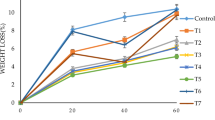Abstract
A whey protein isolate (WPI) based carbon dioxide (CO2) indicator was studied under different CO2 conditions. WPI based CO2 indicators were prepared and incubated in a CO2 filled chamber in order to investigate the CO2 dependent transition behavior in visual appearance. Transparency of the WPI based CO2 indicator with 0.1% WPI changed from 91.8% to 24.6%. An indicator with 0.3% WPI changed from 73.7% to 7.7%. The change in visual appearance at the transition point was definite. The indicator showed an irreversible visual change due to the hysteresis behavior of the indicator. Desorption of CO2 did not restore the transparency. The CO2 dependent visual transition point was controlled by adding different concentrations of NaCl to the indicators. A WPI based CO2 indicator has potential for application as a CO2 dependent spoilage and over-ripeness indicator for a variety of foods.
Similar content being viewed by others
References
Ahvenainen R, Hurme E. Active and smart packaging for meeting consumer demands for quality and safety. Food Addit. Contam. 14: 753–763 (1997)
Jung J, Lee K, Puligundla P, Ko S. Chitosan-based carbon dioxide indicator to communicate the onset of kimchi ripening. LWT-Food Sci. Technol. 54: 101–106 (2013)
Puligundla P, Jung J, Ko S. Carbon dioxide sensors for intelligent food packaging applications. Food Control. 25: 328–333 (2012)
Chanamai R, McClements DJ. Comparison of gum arabic, modified starch, and whey protein isolate as emulsifiers: influence of pH, CaCl2 and temperature. J. Food Sci. 67: 120–125 (2002)
Malamud D, Drysdale JW. Isoelectric points of proteins: A table. Anal. Biochem. 86: 620–647 (1978)
Demetriades K, Coupland JN, McClements DJ. Physical properties of whey protein stabilized emulsions as related to pH and NaCl. J. Food Sci. 62: 342–347 (1997)
Duran L, Calvo C. Optical properties of foods. Vol. I, pp. 120–142. In: Food Engineering. Barbosa-Cánovas GV (ed). Encyclopedia of Life Support Systems. Mississauga, Ontario, Canada (2009)
Jönsson B, Karlström G, Wennerström H, Roos B. Ab initio molecular orbital calculations on the water-carbon dioxide system: carbonic acid. Chem. Phys. Lett. 41: 317–320 (1976)
Ko S, Gunasekaran S. In situ microstructure evaluation during gelation of â-lactoglobulin. J. Food Eng. 90: 161–170 (2009)
Author information
Authors and Affiliations
Corresponding author
Rights and permissions
About this article
Cite this article
Lee, K., Ko, S. Proof-of-concept study of a whey protein isolate based carbon dioxide indicator to measure the shelf-life of packaged foods. Food Sci Biotechnol 23, 115–120 (2014). https://doi.org/10.1007/s10068-014-0015-6
Received:
Revised:
Accepted:
Published:
Issue Date:
DOI: https://doi.org/10.1007/s10068-014-0015-6




